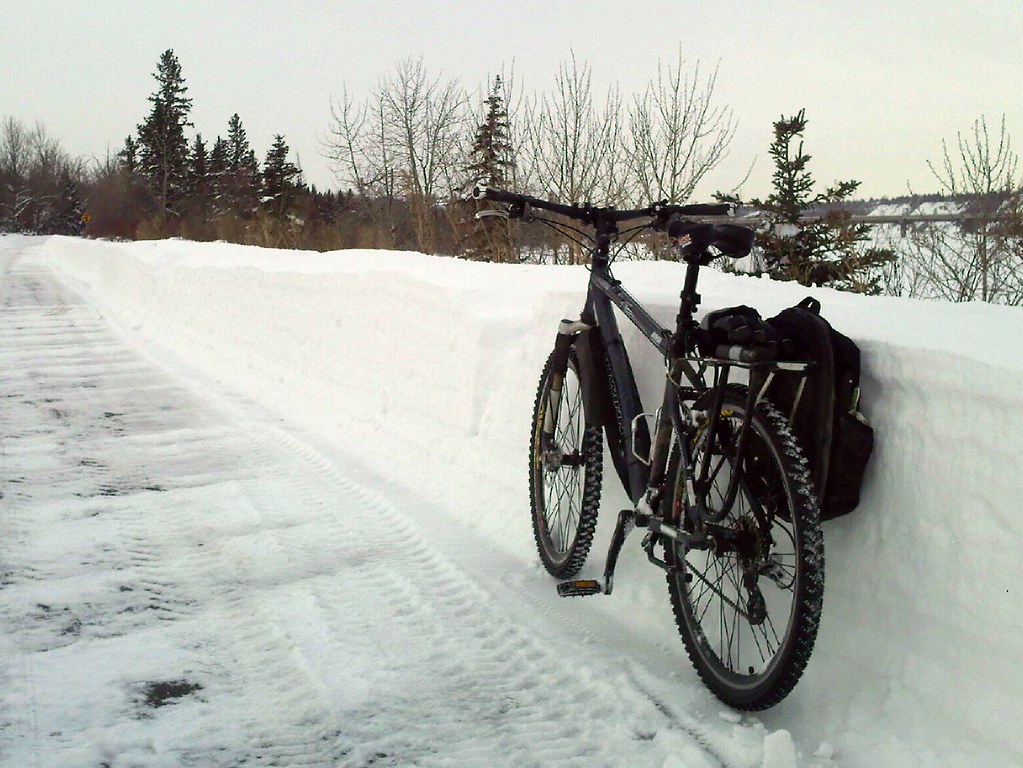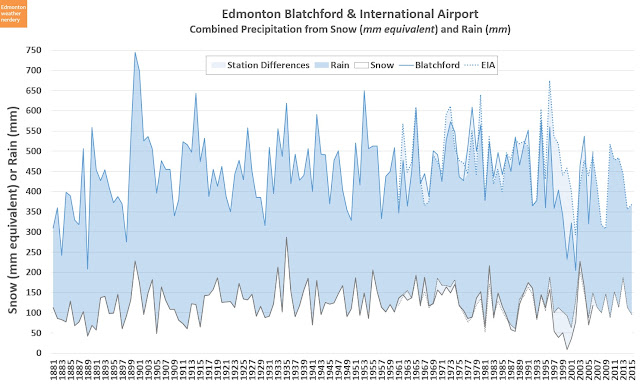Last winter I looked at Edmonton's entire 136-Year recorded history of
warm winter days, and
cold winter days. Today I'm going to look at Edmonton's precipitation history, but it's a little trickier because of the data that is available. Rather than 136 years, it's more like 136-9+55 years worth of precipitation.
I've mentioned before that the precipitation data for the Edmonton Blatchford weather station isn't good, and here is the problem:
Environment Canada makes note of any days that have missing measurements, and from 1881 through 2006 things went pretty well. But in 2007 there were 31 days with missing precipitation data. In 2008 through 2013, each of those years had more than 200 days with missing measurements. And finally, in 2014 all 365 days are missing. Then 2015 dropped to a more reasonable 89, and so far in 2016 there has only been 1.
I'm not sure what caused this - why after more than a century of record keeping would you just take a little break? One might think that the closure of the airport had something to do with it, but the vote to close the airport wasn't until 2009, and the first runway closure was in 2010. The Edmonton Indy might seem to be another possible factor, but it started earlier in 2005 and lasted through to 2012.
So I don't know what caused the gaps in the data. I just know that they are there.
Those gaps mean that the Blatchford data can't be used for any current comparisons, or trends, or averages. But there is still more that a century of data to look at.
For the missing recent history the Edmonton International Airport is available as an alternative, although it only has data back to 1961:
This is a comparison of the Edmonton International and Blatchford, and the purple line along the bottom is the difference between the two stations each year.
From 1961 through 1995 the two stations were within +/-75mm of each other every year, which is about 20%. But then in 1995 the Blatchford numbers started to drop off, and in 2000 the difference between the two stations peaked at 218mm. Precipitation is much more local than temperatures, and it's possible that the International received a few big storms that the downtown didn't. But 451mm at the International vs 233mm at Blatchford is pretty huge
(almost 50%, and over 3 standard deviations from the mean).
Knowing the problems with the 2007-2015 Blatchford data, this does make me wonder if maybe there are some unreported errors in the 1995-2000 era? But I'll come back to that in a bit. For now, lets just take a closer look at the Blatchford data:
I'd tried to add a trendline to the Blatchford data, but it wasn't very interesting, so it isn't shown. Things are low at the beginning, low at the end, and flat in the middle, so the trend for the century just looks flat.
So instead of a trendline here is the 5-Year moving average, which removes some of the year-to-year noisiness. And for almost a century - from about 1905 through 1995 - that average fluctuated back and forth in the range of 400-535mm per year.
I tend to think of the 1930's as a time of extreme drought, because of all of the photos of the dustbowl and the stories of the depression. But at least for Edmonton that is a little hard to spot in the data. 1929 was low, and 1930 was very low at just above 300mm (making it the 8th lowest year). But after 1930 the precipitation quickly recovered, even if the economy didn't. And the lows of the early 1930s are pretty comparable to the early 1920s, early 1950s and much of the 1960s.
The only times that the average broke out of the 400-535mm band were at the beginning and the end of the century. 1900 and 1901 both had about 60% more precipitation than the 20th century average. And then the late 1800s and early 2000s had some years that were as low as half the average.
Here is the Edmonton International data, with the same 400-535mm range shaded in. And we can see that for the most part the International stays within that band as well.
Unfortunately there isn't a lot of overlap in the highest and lowest years for the two stations, mostly because many of Blatchford's extremes were a century ago. But one thing that is common between the two charts is 2002, which had the lowest recorded precipitation for both Blatchford and for the International. Even though it is the lowest at both stations, there is still a significant difference in the measurements, with Blatchford at 188mm and the International at 267mm.
Last year a state of agricultural emergency was declared, because there had been so little precipitation. But based on the numbers for the International, 2015 still had 40% more precipitation than 2002. On the other hand though, looking at the 5-Year average we have now had a string of relatively dry years, and the last year with a lot of precipitation was all the way back in 1996. For about the last 15 years the average has been sitting at the bottom of that 400-535mm range.
And that brings us back to the Blatchford data. From 2000 onwards the precipitation at the International is fairly low, but at Blatchford it absolutely nosedived. Which one is right? Or are they both right? It's time to look at some other stations for comparison.
Edmonton has other stations with precipitation data, and two of them - the University of Alberta Metabolic Centre, and Stony Plain - are shown here.
This is a very busy chart, and I won't look at it in too much detail - Stony Plain tends to be a little higher than the other stations, taking top spot in 18 of the 31 years shown here; and all 4 stations show a downward trend since the mid-80s.
The main point of interest here is the years from about 1995-2002, where the Blatchford data is significantly lower than all three of the other stations. Precipitation is local, but I'm suspicious that Blatchford really only received half as much precipitation as the University did in 2000. So I already know that Blatchford's 2007-2015 data has problems, but I think that 1995-2002 looks pretty dubious as well.
I've previously said that I don't like the recent Blatchford precipitation data, and this confirms that. It's still interesting for some historic records, but in the future I'll continue to use the International whenever I'm looking at recent precipitation.
One final thing for today:
Environment Canada records the totals for rain and for snow, and they are shown in the graph above. This is the mm-equivalent of melted snow. If I used the freshly fallen unmelted snow the numbers are 10x as much, but that distorts the graph. Next winter I will definitely take a closer look at Edmonton's snowfall. But for now, this gives a sense of roughly how much of our yearly precipitation comes from snow or rain - for snow the average is 120mm versus 330mm for rain.
Update: I've reworked some of these charts using a different Blatchford dataset, which gives less suspicious results for the 1995-2005 period. The update can be found here.













































